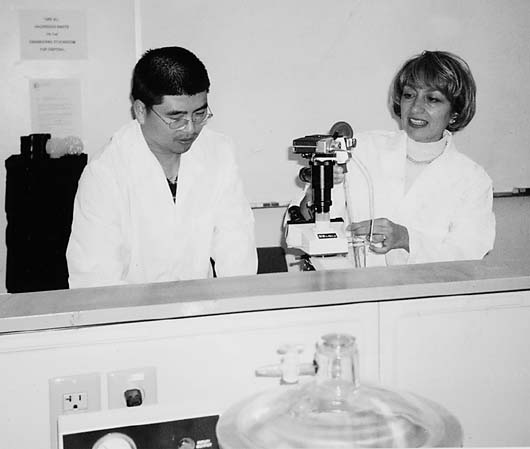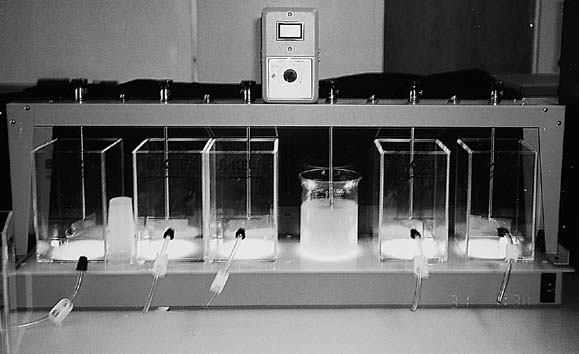
College of Science & Engineering Alumni Newsletter
Fall
2001
Environmental Engineering Laboratory

College of Science & Engineering Alumni Newsletter
Fall
2001
Environmental Engineering Laboratory
On
December 13, 2000, the new Environmental Engineering Laboratory located
in Science 155 opened its doors to the campus community and off-campus
professionals in an open house event to showcase the state of the art equipment
and set-up stationed on its benches. This was an event to present the fruit
of six years of resource investment by the college of Science and Engineering.
Amongst those attending the Open House were students, faculty, Associate
Dean, Dean and the University Administration, faculty from outside College
of Science and Engineering such as Broadcast and Electronic Communication
Arts (BECA), representatives from US Environmental Protection Agency, California
Environmental Protection Agency, San Francisco Airport Environmental Control
Division, City of San Francisco, and University of California Environmental
Engineering Department. They all took tours of the facility.
The
guiding principle behind the design of this laboratory has been to develop,
maintain, and continuously upgrade a facility that has state-of-the art
equipment and meets the needs of the community in training students knowledgeable
in both fundamental and cutting edge experimentation. Thus the lab is a
work in progress! However, for many aspects of the laboratory design a
close alliance was established with University of California at Berkeley,
Environmental Engineering Department.
This
laboratory is designed to serve as a single place to conduct water and
wastewater analysis and treatment. In this regard, it is unique amongst
Bay Area University laboratories.
The
original design in 1994 started by Dr. Elahe Enssani, PE, faculty of Environmental
Engineering. As a start, she contacted Bay Area Universities that have
a strong Environmental Engineering Program. She evaluated the kinds of
water quality laboratories they had available for instruction. A lot of
thought went into design of the experiments and many pages were created
of sketches of the experimental set-up, list of required equipment, numerous
organic and inorganic chemicals, hundreds of various glassware, safety
equipment, and most importantly, a location for the laboratory equipped
with fume-hood, necessary plumbing with cold and hot water sink, 220 and
110 voltage lines, distilled water and safety features such as shower and
eye wash, waste sink under the fume-hood, etc. The task was enormous
and many people supported the creation of what stands now in Science 155.
The
experiments are designed in a series of chemical analyses and procedures
to examine the quality of water and wastewater samples physically, chemically,
and biologically. The quality examination identifies impurities, pollutants
and contaminants in the water samples brought out to the lab. It is then
followed by series of operations and processes aimed at removal of the
identified pollutants and contaminants. The primary focus of this laboratory
has been undergraduate and graduate teaching. However, as the laboratory
was being developed and as early as 1998, research funding was obtained
to conduct graduate research on various methods for removal of pollutants.
Since then, 5 graduate students and one visiting scholar from Germany have
completed or are currently conducting experimental research projects in
this laboratory.
The
teaching experiments are designed to conduct the necessary analyses required
to determine suitability of water for domestic use. The experiments are
according to the ones in the book “Standard Methods for the Examination
of water and wastewater”. This book, published by the American Public Health
Association, is the bible of water quality analysis. The students follow
pages of the book in association with handouts given at the introduction
of each experiment which represent the custom-designed, updated step by
step tasks specifically for the lab.
The
analyses experiments are as follows: Total, Settleable and Dissolved Solids,
Color and Turbidity, Dissolved Oxygen, PH, Alkalinity, Chemical Oxygen
Demand (COD), Biological Oxygen Demand (BOD), Nitrogen Compounds (Organic
and Inorganic nitrogen), Oil and Grease, Gas Analysis using chromatography
(Carbon Dioxide, Methane)
The treatment experiments
are as follows: Solids Removal, Color and Turbidity Removal, Nitrogen Removal
both using Biological and Physical/Chemical Method, Oil and Grease Removal
and Biological Removal of Organic Compounds using both Aerobic (Activated
Sludge reactor) and Anaerobic Method (Methane Fermentation reactors).
We are already looking
for funding for the next set of treatment (contaminant removal) technologies.
These are Water Filtration, Ion Exchange, and Membrane Technologies such
as Reverse Osmosis.
Throughout
the design of the laboratory and experiments, space efficiency and waste
minimization has been emphasized. The number of units ordered or assembled
has also been optimized according to the estimated number of students in
each group and also the estimated number of groups.
Determination
of total, suspended, and dissolved solids is done using the gravimetric
method of solids analysis. Turbidity of water is measured using a turbidity
meter. The color of water is determined using the spectrophotometer while
the dissolved oxygen and PH of water are measured using the electrode methods
as well as a chemical method of dissolved oxygen determination. The students
will learn to measure Alkalinity using the titration method. COD is measured
using a micro-COD apparatus. This is a cutting edge method and minimizes
the amount of sample used and thus reduces the generated waste. Nitrogen
compounds are measured in elaborate, complete Kjeldahl nitrogen
apparatus. Oil and grease are measured in Soxhelet extraction units. The
gas chromatograph has several columns for Carbon Dioxide, Methane, and
Ether compounds.
The
treatment units are either bought off-the shelf then fine-tuned according
to the experiments’ needs, or custom-designed in the laboratory. Color
and Turbidity removal is carried out in a Jar Test apparatus that was bought
then calibrated. Nitrogen, Organic Compounds and Oil and Grease are removed
biologically using biological reactors built in the laboratory. The reactors
are both aerobic and anaerobic. The anaerobic ones reside in state-of-the
art incubators for temperature and odor control. The aerobic reactors are
stationed under the fume-hood for the duration of the experiments then
disassembled and stored when not in use. These are carried out according
to the principles of space efficiency in the laboratory.
In
summary, the importance of a laboratory in and experimental field such
as Environmental Engineering cannot be over-emphasized. The quality of
teaching of such a field is greatly enhanced when the students conduct
the analyses or operate and maintain, and evaluate a treatment process.
Fall 2001 was the first time the laboratory went into operation capable
of conducting all the above-mentioned experiments. The overwhelmingly positive
student feedback only underscored the importance of commitment to the onerous
task of building this laboratory. It also validated the years of hard work
that went into bringing it into fruition.

Sampling and preparation
of Microalgae for viewing under the microscope.

Microscopic view of Microalgae
grown in MTBE solution.

Jar Test apparatus
for removal of Color and Turbidity in water.